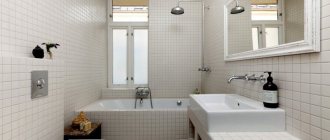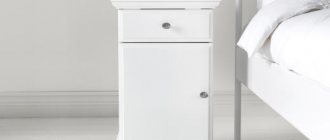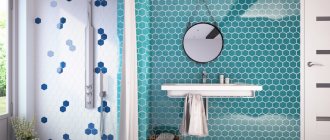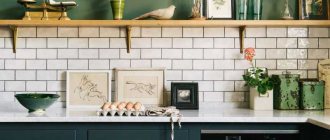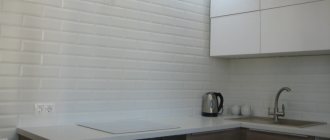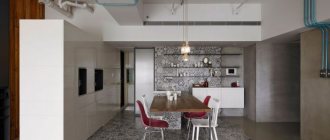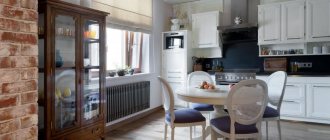Ceramic facing tiles are successfully used both for finishing interior walls and floors. The priority is considered to be excellent technical characteristics of the material and beautiful appearance. When decorating a hallway, there are some features that should be taken into account during the installation of tiled or porcelain tiles. A wide selection of finishing materials and their color range opens up great opportunities for designers when decorating a room, as beautifully illustrated by the photos in the article.
Seamless tiles with a concrete effect in the hallway
Material properties
High-quality floor tiles in the hallway must be durable. The coating must withstand mechanical damage, for example from being hit by a heavy object, and there should also be no scratches on it.
In international practice, it is customary to evaluate the wear resistance of tiles according to classes. Ceramic tiles for hallways marked REI 4 and REI 5 are the most wear-resistant. Such tiles are not afraid of not only mechanical damage, but also exposure to chemicals.
The water-repellent properties of tiles can be assessed with the naked eye. The chip of a tile that is not afraid of water should be smooth, without pores, and red in color.
Decorative tiles for the hallway can also be grades R10 and R11, these are tiles with a low slip coefficient.
Types of tiles
Floor tiles in the hallway can be made from several materials, each of which has its own characteristics.
Ceramic tile. Such tiles tolerate temperature changes well, are easy to clean, and are not afraid of chemical influences. The only drawback is its fragility; the tiles crack when struck by a heavy object, for example after a cane umbrella falls.
Porcelain stoneware. It is made from a mixture of sand and granite chips. Such tiles are very strong and durable, are not afraid of impacts, and can imitate parquet boards or natural stone. This is one of the most expensive types of tiles.
Clinker tiles. Very durable ceramics, differs from conventional firing method. It comes in glossy and matte. It is characterized by high strength and high price compared to ceramics.
Quartz vinyl. This type of tile has appeared in construction stores quite recently. Externally, it is similar to laminate, but more flexible. Laying tiles in the hallway is carried out using the locking method or using special glue.
Methods of combining with other coatings
An example of combining floor tiles and laminate in a hallway.
The combination of two types of floor coverings in the corridor creates the uniqueness of the interior. Especially if the combination used different color schemes of coatings. This is how the zoning of the corridor is created: the hallway zone and the hall zone.
The hallway area, lined with ceramics, is often made in the form of a pedestal. Its height should not exceed 5 cm.
The line where two coatings meet can be straight or curved. A curved joint will require more tile cutting skills. There are flexible thresholds for docking. For a straight joint, the thresholds can even be matched to the overall color of the floor covering. This way the transition from tiles to another type of coating will be more harmonious.
Floor design in the hallway, a combination of several materials.
Ceramic tiles look good in combination with laminate.
Floor tiles in the hallway are a presentation of the interior of your home. In the eyes of your guests, you will look like a person with taste, and the decoration of your home will be fashionable and unique.
Useful tips
To choose high-quality tiles for the floor in the hallway, follow the advice of specialist tilers:
- Choose tiles that are not afraid of mechanical damage and exposure to aggressive detergents;
- Use waterproof smooth compounds to grout the seams; all the dirt from the street most often accumulates on the seams;
- You should not choose tiles that are too light; remember that household members in dirty shoes will constantly trample around in the hallway;
- The floor tiles in the hallway should be embossed or covered with a non-slip coating, otherwise you will often slip on them when walking home in wet shoes.
Design
A huge selection of ceramic tiles allows you to select materials in any style and in any color scheme. And this, in turn, opens up unprecedented opportunities for decorators.
How can you decorate your hallway using this wonderful material?
Space decoration
KP is equally successfully used for complete cladding of a floor or wall and for partial cladding. It all depends on the overall design and practicality of the solution.
- Most often, the floor is covered entirely with tiles. Moreover, usually the same material is used for lining corridors: the same floor in several rooms creates the feeling of more space. If the color, texture, or at least the style of the ceramics matches the nature of the floor in the living room and bedroom, the impression of community, a single space in the home is enhanced.
If it is not possible to cover the corridor with CP, which is sad, then the color and texture of the tiles must be combined with the floor material.
- CP has two drawbacks - its surface is always cool. This is acceptable for the hallway, but may be undesirable for the corridor, especially if the apartment’s inhabitants do not have the habit of wearing house shoes. Another disadvantage is the ringing sound; ceramics do not dampen the sound at all, and this can be very annoying. To avoid this, tiles are used to cover only the area in front of the front door. However, the requirements for the combination of materials remain in force.
- If the hallway is a large room - for example, it forms one whole with a common corridor or simply has a large area, they resort to zoning. In this case, either different tiles or a combination of them with some other suitable material can be used.
Color restrictions
There are no restrictions on color: KP can have any shade thanks to coloring pigments or glaze, if we are talking about wall tiles. However, color influences the interior more than it seems, so matching the color scheme alone is not enough.
- Light pastel shades, of course, visually increase the area. However, the slightest dirt will be noticeable on such a floor. No matter how well the ceramics are washed, few people want to devote half an hour every day to cleaning the hallway.
- Too dark an intense color emphasizes scratches and abrasions, and on a smooth dark surface, dust is no less noticeable.
- Universal shades include muted tones, and even better ceramics with an uneven color distribution. Usually this is a material with a natural color range for clay - cotto, clinker, red tiles, gress. A stone or wood finish solves the problem perfectly, since the combination of a pattern and several shades makes even a polished surface non-marking.
- Another solution is a pattern. Ornamental, geometric, fashionable patchwork - the ornament is chosen based on the style of the hallway.
- An original, but also quite suitable solution for the hall is metallized tiles. In a loft or techno style, imitation steel or bronze flooring would be quite appropriate.
- It is also necessary to take into account the tone: cool shades visually distance the surface, and at the same time the room seems larger. Warm ones bring them closer and, accordingly, reduce the volume of the hallway.
Tile and laminate flooring in the hallway (photo)
Billing solutions
If we exclude polished surfaces, which are mostly neglected, the choice of textures for the floor is not so large. You can’t use embossed products - it’s uncomfortable to walk on, but a structured surface is allowed.
- Matte is a regular solid CP with good non-slip properties. Perfectly conveys color. It is on matte tiles that dirt is least noticeable.
- Satin – surface with micro-relief. It is even more non-slip, but at the same time enhances the shade. If a light color is chosen for decoration, then this option is preferable.
- Structured - reproduces the texture of wood, stone, leather, and so on. For the floor, the choice is limited to the wood structure, but for wall cladding, any option can be used. At the same time, light-colored textured tiles on the floor are impractical - they are more difficult to clean.
For the wall, there are no restrictions other than style.
Dimensions and shape
The hardness and strength of the CP allows us to produce products of a wide variety of sizes and no less different shapes. You can use almost anything to decorate the hallway, but take into account the size and shape of the hall itself.
- Large blocks emphasize the size of the room: they visually reduce a small area and enlarge an already spacious room.
- Mosaic can only be used as a panel. This element is too decorative.
- Medium-sized tiles are quite suitable for tiling a small hallway. This option will break up a large plane, which should not be allowed.
- The best option for hallways is to lay medium and small tiles in a geometric pattern. Moreover, this is a universal solution for both floors and walls. This order structures the surface and creates the impression of harmony.
- The combination of tiles of different sizes and two or three different colors is very impressive. In this way, you can connect the entire color ensemble of the hallway, corridor and even apartment into a single whole.
- Tiles of complex shape are perfect for laying on the floor, but when facing walls they can only be used in the form of fragments. The reason is its high decorative value; on the wall it attracts more attention than on the floor.
The video below talks about tiling floors in the hallway, kitchen and other rooms:
Laying the material
Even if you use ordinary rectangular or square tiles of the most ordinary color, you can achieve interesting results if you lay them in an unusual way.
- In a straight line - the usual laying in a row, the simplest and most economical.
- Diagonally , the material has to be trimmed, and in large quantities. However, diagonal laying noticeably expands the room and visually corrects the proportions, so this method is used very often.
- Offset masonry – brick, for rectangular tiles. The best solution for decoration in country, Provence, Mediterranean style.
- Parquet - implemented using tiles that imitate wood, and using any other rectangular product. Moreover, you can decorate the walls in this way. But, since the texture is better visible in a dark color, parquet installation is usually applied in fragments.
- Modular - made of tiles of the same or different sizes. The module is a complete decorative element, sometimes very complex.
- Carpet - any layout using decorative elements - modules, borders and even complex panels that form a single whole.
For the hallway you can find ready-made collections, which include floor and wall tiles of the same or matching colors with common decorative elements. This finish is a complete harmonious ensemble and is very comfortable.
Tile on the walls in the hallway (photo)
Color solution
Both too light and too dark shades of tiles are not suitable for the hallway. On a light one, every speck will be visible, and on a dark one, scratches and dust will be clearly visible.
It’s better to opt for intermediate options or combined tiles for the hallway. The most suitable colors would be beige, gray or brown.
Cool shades of tiles will make the hallway feel more spacious. Contrasting combinations will make a small corridor even smaller.
The color of the tiles on the floor can be in harmony with the flooring in the rest of the house or, on the contrary, deliberately contrast with it to emphasize zoning.
Decorating the hallway with decorative stone
The walls of the hallway are what catches the eye of any entering guest. Every day the hallway is the very first thing that greets you at home. Therefore, the entrance to the house must have a certain style and be in harmony with the rest of the design of the apartment or house. Which of the many cladding options will be chosen is up to you. We will just reveal a few nuances, knowledge of which will protect you from possible mistakes:
- Often there is not enough natural lighting at the entrance to the apartment. By using materials in warm colors, you will avoid creating a gloomy room.
- Decorating a small corridor with decorative stone and small tiles will visually increase its size. Large elements will visually weigh down an already small space.
- The problem with a wall that has a geometrically complex location can be solved by using flexible stone. The sheets cut and bend well, which makes it possible to cover even rounded corners.
Decorative stone in the house Source catalog6.ru.net/
- Decorative stone is considered a self-sufficient material. You should not add unnecessary decoration (paintings, shelves, photographs) to it. It will be better if the wall remains free.
- The textured surface is highlighted by installing additional vertical lighting. The maximum effect is achieved by using rays propagating from bottom to top.
- You can create an optical illusion and enlarge a small hallway space using the opposite mirror wall.
- The natural warmth of wood will be an excellent complement to the coolness of the stone. Both types of material, when used in the same room, merge into a single harmony.
In warm colors Source krrot.net
Natural stone tiles on the floor Source www.keramis.com.ua
Shape and size
Since the hallway is often small in size, it is more rational to use small-sized tiles; it will be easier to lay them, and the cost of trimming will be less than for large tiles.
Large tiles also have their advantages: in large corridors they lay the floor much faster, there are fewer seams on the surface, which means less dirt will accumulate.
In spacious hallways, a combination of tiles of different sizes is acceptable.
Texture
The texture of the tile greatly influences its visual perception, but it is worth remembering the technical characteristics of different types of tiles.
Glossy. Gloss always visually expands the space and makes the hallway brighter. However, glossy tiles will have to be washed all the time, and they are also very slippery.
Matte. This tile design in the hallway looks noble and calm. Water stains are not visible on such tiles and they do not slip. Dirt can accumulate more often in rough surfaces.
Textured. Relief tiles are more difficult to maintain, but with their help you can easily imitate other materials, such as brick or wood.
Nuances of choosing wall coverings
From the variety of materials offered for wall decoration, in the hallway you need to choose those that have the following characteristics:
- resistance to damage;
- wear resistance;
- ease of care;
- moisture resistance;
- strength;
- aesthetic appearance.
There are a huge number of variations in wall design using different types of coatings; after studying various photos of wall decor in the hallway, you can choose the option that best suits your tastes and preferences and implement it in your apartment.
Before purchasing the type of coating you like, analyze the design features of the room being decorated, its microclimate, your financial capabilities, the compliance of the selected materials with the overall interior design, the smoothness of the decorated surface, etc.
In order to figure out how suitable this or that wall covering will be for your hallway, let's talk in more detail about each.
Tile laying methods
There are several standard methods for laying tiles:
- Laying in even rows. This type of installation is the simplest technically. Even rows of tiles in the hallway interior always look appropriate;
- Laying diagonally. Usually the tiles are laid at an angle of 45 to one of the walls; you can choose a different angle;
- Offset or brick laying. You can move the tiles by half or more;
- Modular. A decorative pattern is laid out in the center of the hallway, the rest of the tiles are laid out evenly around.
Features of wall decoration in the hallway with tiled or ceramic tiles
The high-quality decoration of the interior of the hallway largely depends on the choice of the type and shape of the ceramic material, as well as on the selection of the overall design.
How to choose the right tile for the wall, what to combine it with correctly? What is the advantage of decorative tiling? Home renovation always involves the purchase of materials, thanks to which you can beautifully decorate a pre-designed interior design. Modern industry offers the potential buyer many options for finishing materials that allow you to radically transform the room, fill it with comfort and homeliness, light and air, visually expand or narrow the room. Decorating the hallway walls with ceramic tiles is not the most common, but it is an option that has a number of advantages.
Tiles and interior style
Tiles are great for their versatility and suit all interior styles, but there are a few types of flooring that look best in certain styles.
The loft-style hallway tends to use simple materials. Imitation of natural stone or aged tiles also look good in a loft.
An entrance hall in a romantic Provence style requires the same delicate tiles. In photos of such designer hallways, small, light-colored tiles with a floral pattern often appear.
For a modern style, the use of almost any tile is acceptable. Tiles with imitation parquet and hexagonal honeycomb tiles look original.
In a classic interior, the floor should have natural stone or wood. Imitation ceramic tiles can easily replace expensive materials.
For a minimalist hallway, glossy plain tiles without seams are suitable.
Modern manufacturers offer many types of tiles, differing in texture, color, pattern and size. Choose exactly the covering that will make your home cozy and beautiful, starting from the threshold.
Wallpaper
Wallpaper continues to be a classic of the genre when decorating any room in an apartment. And this is not surprising, the different quality of the paintings allows them to be used in any room, regardless of its purpose, and the varied colors, designs, patterns, textures of such a coating will easily fit into any interior.
Decorating with wallpaper makes it possible to embody all sorts of ideas and fantasies on the walls of the hallway; it allows you to combine several types of canvases that differ in shades and textures, which allows you to create your own unique style.
For finishing the corridor, it is better to give preference to non-woven, vinyl or liquid wallpaper. Paper-based canvases are not suitable for this room, as they cannot be wet cleaned.
As for non-woven fabric and vinyl, they will perfectly hide existing surface unevenness, and, like liquid wallpaper, they are durable, resistant to mechanical damage, and easy to clean.
